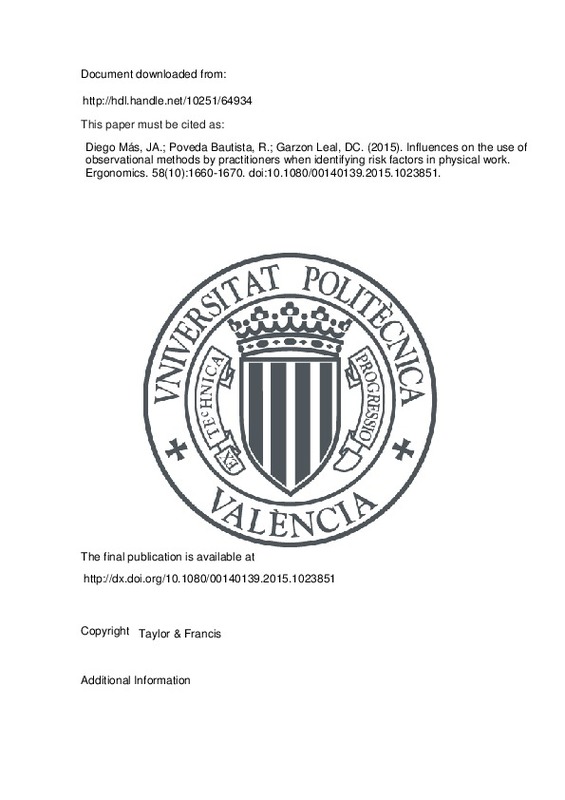BraceIan. 2013. Questionnaire Design: How to Plan, Structure, and Write Survey Material for Effective Market Research. 3rd ed. Edited by DavidBarr and RobinBirn. London: Kogan Page.
BuckleP., and G.Li. 1996. “User Needs in Exposure Assessment for Musculoskeletal Risk Assessment.” In Proceedings of 1st International Cyberspace Conference on Ergonomics ‘Cyberg’.
Chaffin, D. B. (1969). A computerized biomechanical model—Development of and use in studying gross body actions. Journal of Biomechanics, 2(4), 429-441. doi:10.1016/0021-9290(69)90018-9
[+]
BraceIan. 2013. Questionnaire Design: How to Plan, Structure, and Write Survey Material for Effective Market Research. 3rd ed. Edited by DavidBarr and RobinBirn. London: Kogan Page.
BuckleP., and G.Li. 1996. “User Needs in Exposure Assessment for Musculoskeletal Risk Assessment.” In Proceedings of 1st International Cyberspace Conference on Ergonomics ‘Cyberg’.
Chaffin, D. B. (1969). A computerized biomechanical model—Development of and use in studying gross body actions. Journal of Biomechanics, 2(4), 429-441. doi:10.1016/0021-9290(69)90018-9
David, G. C. (2005). Ergonomic methods for assessing exposure to risk factors for work-related musculoskeletal disorders. Occupational Medicine, 55(3), 190-199. doi:10.1093/occmed/kqi082
David, G., Woods, V., Li, G., & Buckle, P. (2008). The development of the Quick Exposure Check (QEC) for assessing exposure to risk factors for work-related musculoskeletal disorders. Applied Ergonomics, 39(1), 57-69. doi:10.1016/j.apergo.2007.03.002
Dempsey, P. G., McGorry, R. W., & Maynard, W. S. (2005). A survey of tools and methods used by certified professional ergonomists. Applied Ergonomics, 36(4), 489-503. doi:10.1016/j.apergo.2005.01.007
Genaidy, A. M., Al-Shedi, A. A., & Karwowski, W. (1994). Postural stress analysis in industry. Applied Ergonomics, 25(2), 77-87. doi:10.1016/0003-6870(94)90068-x
Government of Ontario (Canada). 2011. “Occupational Health and Safety Act.” Accessed May 21, 2014. http://www.e-laws.gov.on.ca/html/statutes/english/elaws_statutes_90o01_e.htm.
Hignett, S., & McAtamney, L. (2000). Rapid Entire Body Assessment (REBA). Applied Ergonomics, 31(2), 201-205. doi:10.1016/s0003-6870(99)00039-3
Karhu, O., Kansi, P., & Kuorinka, I. (1977). Correcting working postures in industry: A practical method for analysis. Applied Ergonomics, 8(4), 199-201. doi:10.1016/0003-6870(77)90164-8
Kitchenham, B., & Pfleeger, S. L. (2003). Principles of survey research part 6. ACM SIGSOFT Software Engineering Notes, 28(2), 24. doi:10.1145/638750.638758
LI, G., & BUCKLE, P. (1999). Current techniques for assessing physical exposure to work-related musculoskeletal risks, with emphasis on posture-based methods. Ergonomics, 42(5), 674-695. doi:10.1080/001401399185388
MalchaireJacques. 2011. A Classification of Methods for Assessing and/or Preventing the Risks of Musculoskeletal Disorders. Brussels: European Trade Union Institute. https://www.etui.org/content/download/4972/49930/file/Guide+MSD-web.pdf.
McAtamney, L., & Nigel Corlett, E. (1993). RULA: a survey method for the investigation of work-related upper limb disorders. Applied Ergonomics, 24(2), 91-99. doi:10.1016/0003-6870(93)90080-s
OCCHIPINTI, E. (1998). OCRA: a concise index for the assessment of exposure to repetitive movements of the upper limbs. Ergonomics, 41(9), 1290-1311. doi:10.1080/001401398186315
OHSCO (Occupational Health and Safety Council of Ontario). 2008. “Musculoskeletal Disorders Prevention Series. Part 3C: MSD Prevention Toolbox – More on in-Depth Risk Assessment Methods.” OHSCO. http://www.iwh.on.ca/system/files/documents/msd_prevention_toolbox_3c_2007.pdf.
Pascual, S. A., & Naqvi, S. (2008). An Investigation of Ergonomics Analysis Tools Used in Industry in the Identification of Work-Related Musculoskeletal Disorders. International Journal of Occupational Safety and Ergonomics, 14(2), 237-245. doi:10.1080/10803548.2008.11076755
Savage, S. J., & Waldman, D. M. (2008). Learning and fatigue during choice experiments: a comparison of online and mail survey modes. Journal of Applied Econometrics, 23(3), 351-371. doi:10.1002/jae.984
SiegelSidney, and N. J.Castellan. 1988. Nonparametric Statistics for the Behavioral Sciences. 2nd ed. http://www.redi-bw.de/db/ebsco.php/search.ebscohost.com/login.aspx?direct = true&db = psyh&AN = 1988-97307-000&site = ehost-live.
Snook, S. H., & Ciriello, V. M. (1991). The design of manual handling tasks: revised tables of maximum acceptable weights and forces. Ergonomics, 34(9), 1197-1213. doi:10.1080/00140139108964855
Steven Moore, J., & Garg, A. (1995). The Strain Index: A Proposed Method to Analyze Jobs For Risk of Distal Upper Extremity Disorders. American Industrial Hygiene Association Journal, 56(5), 443-458. doi:10.1080/15428119591016863
Takala, E.-P., Pehkonen, I., Forsman, M., Hansson, G.-Å., Mathiassen, S. E., Neumann, W. P., … Winkel, J. (2009). Systematic evaluation of observational methods assessing biomechanical exposures at work. Scandinavian Journal of Work, Environment & Health, 36(1), 3-24. doi:10.5271/sjweh.2876
Trask, C., Mathiassen, S. E., Wahlström, J., Heiden, M., & Rezagholi, M. (2012). Data collection costs in industrial environments for three occupational posture exposure assessment methods. BMC Medical Research Methodology, 12(1). doi:10.1186/1471-2288-12-89
University of Surrey. 2003. “Assessing Musculoskeletal Disorders at Work: Which Tools to Use When? Guildford: University of Surrey.” . http://www.hse.gov.uk/research/crr_pdf/1999/crr99251.pdf.
Van der Beek, A. J., & Frings-Dresen, M. H. (1998). Assessment of mechanical exposure in ergonomic epidemiology. Occupational and Environmental Medicine, 55(5), 291-299. doi:10.1136/oem.55.5.291
WATERS, T. R., PUTZ-ANDERSON, V., GARG, A., & FINE, L. J. (1993). Revised NIOSH equation for the design and evaluation of manual lifting tasks. Ergonomics, 36(7), 749-776. doi:10.1080/00140139308967940
[-]







![[Cerrado]](/themes/UPV/images/candado.png)


